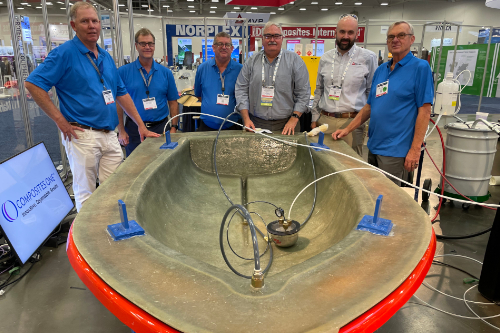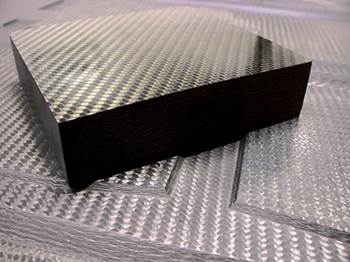Space
Composites have been used in space since our early steps into the cosmos. Often turned to for their light weight and high strength, these materials have a history of use in spaceflight in such applications as payload fairings, satellite structures and heat shields. ► Explore the technologies, materials and strategies used by composites manufacturers working in the evolving space market at our virtual CW Tech Days: New Space Applications. Learn more and register here!

ESSENTIAL READING
VIEW ALLMaterials & Processes: Composites fibers and resins
Compared to legacy materials like steel, aluminum, iron and titanium, composites are still coming of age, and only just now are being better understood by design and manufacturing engineers. However, composites’ physical properties — combined with unbeatable light weight — make them undeniably attractive.
Read MoreMaterials & Processes: Resin matrices for composites
The matrix binds the fiber reinforcement, gives the composite component its shape and determines its surface quality. A composite matrix may be a polymer, ceramic, metal or carbon. Here’s a guide to selection.
Read MoreMaterials & Processes: Introduction
High strength at low weight remain the winning combination that propels composite materials into new arenas, but other properties are equally important. This article outlines the case for composites and introduces SourceBook's overview of the materials and processes used to make them.
Read MoreKnowledge Centers

This CW Tech Days event will explore the technologies, materials, and strategies that can help composites manufacturers become more sustainable.
LEARN MORE
Closed mold processes offer many advantages over open molding. This knowledge center details the basics of closed mold methods and the products and tools essential to producing a part correctly.
LEARN MORE
Join us for insights into advanced bonding techniques and welding processes for composite materials to ensure durability and structural integrity.
LEARN MORELatest Space News And Updates
Airborne to supply Airbus with composite components for mega-constellation satellite solar arrays
Airborne Aerospace will manufacture more than 700 composite substrate panels and yoke substrates for Airbus Sparkwing solar arrays, a critical component of MDA Space’s Aurora satellite product line.
Read MoreAirborne completes final delivery of CFRP mirror structures for Fred Young Submillimeter Telescope
Airborne, with the help of partners, designed, manufactured and assembled two 6-meter-diameter mirror support structures for highly complex scientific telescope project.
WatchFibreCoat secures up to €20 million for coatings maturation
Metal- and plastics-coated fiber innovator aims to rapidly grow radiation-, heat- and EMI-resistant material offerings for space and defense.
Read MoreAnalySwift receives NASA STTR contract to enable second-use spacecraft infrastructure
Together with Purdue, AnalySwift aims to develop a composite heater layer and a novel software tool or module to achieve assembly, disassembly of thermoplastic composite joints in space during long-duration missions.
Read MoreORNL, Sierra Space create novel C/SiC TPS for reusable space vehicles
CMC tiles will be used on the Sierra Space DC100 Dream Chaser spaceplane carrying critical supplies and science experiments to and from NASA’s ISS.
Read MoreESA collaboration brings Altair software to aerospace, space startups
Access to Altair simulation, AI and data analytics solutions and consulting options to ESA Partnership Initiative for Commercialisation (EPIC) organizations aims to diversify, support aerospace companies.
Read MoreFeatured Posts
Composites business growth through diversification, innovation
San Diego-based 2024 Top Shops qualifier Rock West Composites gives an overview of its relentless commitment to improvement, including its composite capabilities and its role as a trusted player in the space market.
Read MoreVIDEO: Rock West's growth in the space sector
Rock West Composites’ chief strategy officer discusses recent surge in space applications on the CAMX 2024 show floor.
WatchPost Cure: CFRP landing leg supports reusable launcher capabilities
MT Aerospace AG, as part of the EU’s Horizon Europe project SALTO, has successfully developed a 7-meter-long carbon fiber-reinforced polymer (CFRP) landing leg demonstrator using advanced automated fiber placement and 3D printing technologies.
Read MoreLow-cost, efficient CFRP anisogrid lattice structures
CIRA uses patented parallel winding, dry fiber, silicone tooling and resin infusion to cut labor for lightweight, heavily loaded space applications.
Read MoreComposites reinvent aerospace, AAM and space
Celebrating National Composites Week, CW shares ways in which composites continue to make a significant impact in aerospace and space market developments.
Read MoreCarbon fiber satellite arm reduces weight, simplifies assembly onto naval vessels
Satcom developer EM Solutions partnered with ACS Australia to replace an aluminum arm design with a 65% lighter, one-piece, corrosion-resistant carbon fiber/epoxy alternative.
Watch






























